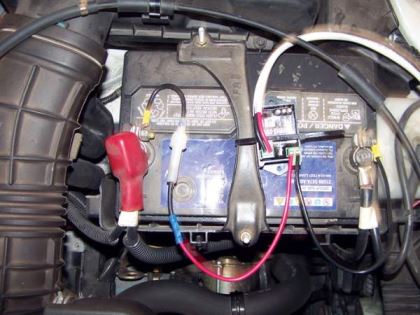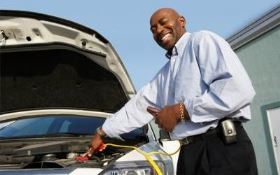Assure that your towable’s battery is up to the task of starting the vehicle once you reach your destination.
By Bill Hendrix, F761s
September 2012
One of the most frustrating things that can occur during an RV trip is arriving at the day’s destination with a discharged battery in the towed vehicle. You pull out the jumper cables, only to realize they are too short to reach the motorhome’s battery. Next, you are presented the task of finding a kind person who will let you get a jump from their vehicle or lend you a battery charger. Usually it’s not difficult to find someone at the campground who is happy to help, but it’s still an inconvenience for them and an embarrassing nuisance for you.
There are many reasons a car’s battery can be drained while it is being towed. Most prominent would be the use of a supplemental braking system that plugs into the vehicle’s 12-volt-DC power outlet. Another might be the car’s electrical system triggered by the ignition switch position. Of course, there may be other less obvious battery drains, such as alarms, monitors, and equipment left on.
In order to keep the towed vehicle’s battery from discharging, you have at least four options available.
Stop And Start
The easiest solution is to stop every two or three hours, start the towed vehicle, and let it idle for five or 10 minutes while you stretch your legs or have a snack. This will provide a fair amount of charge to the battery, but it is a bit of a hassle, and the possibility remains that the battery will not receive enough charge during the brief time it is running to start the vehicle when the destination is reached.
Install A Charge Line
This method makes it possible for the motorhome’s alternator to supply electrical charging to the towed vehicle’s battery via a charge line. The charge line should be 12-gauge stranded wire (or a lower gauge of wire if you have a long run from the motorhome battery to the towed vehicle) with fuses on both ends rated to match both the wire gauge size and the distance the current needs to flow. You also will need a 12-gauge (or lower) stranded, unfused wire for the ground leg. Relying on the towing equipment for a ground is questionable at best. To keep extraneous wiring from hanging between the motorhome and the towed vehicle, bundle the charge line with the wiring harness that plugs into the towed vehicle to operate the taillights and brake lights.
Install A Battery Disconnect Switch With The Charge Line
Although the charge line alone may work well for most, electricity seeks the path of least resistance. Depending on the voltage potential of the motorhome’s batteries, their charging rate, the cleanliness of the connector terminals, and the resistance of the charge line and ground leg, it is still possible for the car battery to become discharged (voice of experience). By taking the car battery out of the circuit with a disconnect switch, either on the positive terminal or on the negative terminal, the towed vehicle will be forced to take current from the coach batteries via the charge line. Just be sure to have the charge line established before disconnecting the car battery, and then reconnect the car battery before unhooking the charge line. That way you never lose current to the car and don’t need to reset the radio, etc. If you fail to reconnect the car battery and attempt to start the car, you will blow one of the fuses on the charge line. My preference is to put the disconnect switch on the negative battery terminal, as it is a safer method of installation. This has worked 100 percent of the time for me, but it requires some manipulation.
Note: This may not be a good option for those who use a supplemental braking system in their towed vehicle that requires electrical power from the towed vehicle battery to operate. The reason is that many of these devices include electrically operated breakaway systems that automatically activate the supplemental brake in the event that the motorhome and towed vehicle separate. Should vehicle separation occur with this type of setup, power from the motorhome to the towed vehicle — and the supplemental braking system — would be cut, disabling the system’s breakaway protection feature. Check with the manufacturer of your supplemental braking system to determine how the breakaway feature operates.
Install A Charging Isolator System
 LSL Products (877-257-4655, www.LSLproducts.com)makes a system called the Toad-Charge. It is an electronic module installed on the charge line at the towed vehicle’s battery and a 15-amp circuit breaker for the source end at the coach batteries. According to the manufacturer, it will monitor and limit the charge rate and prevent any discharge of the car battery. Three LEDs on the module indicate the system’s status: Power, Charging, and Reverse Polarity. If the device is properly connected, the Power light will come on whenever the motorhome engine is supplying it with more than 13.0 volts. The Charging light also will come on whenever the processor is charging the towed vehicle battery. After the motorhome engine is shut off, all the lights go out as soon as the charge line voltage drops to less than 12.8 volts, at which time the processor disconnects the towed vehicle battery from the motor home to prevent discharge. If you have the connection backward, the Reverse Polarity light will come on.
LSL Products (877-257-4655, www.LSLproducts.com)makes a system called the Toad-Charge. It is an electronic module installed on the charge line at the towed vehicle’s battery and a 15-amp circuit breaker for the source end at the coach batteries. According to the manufacturer, it will monitor and limit the charge rate and prevent any discharge of the car battery. Three LEDs on the module indicate the system’s status: Power, Charging, and Reverse Polarity. If the device is properly connected, the Power light will come on whenever the motorhome engine is supplying it with more than 13.0 volts. The Charging light also will come on whenever the processor is charging the towed vehicle battery. After the motorhome engine is shut off, all the lights go out as soon as the charge line voltage drops to less than 12.8 volts, at which time the processor disconnects the towed vehicle battery from the motor home to prevent discharge. If you have the connection backward, the Reverse Polarity light will come on.
Roadmaster Inc. (800-669-9690, www.roadmasterinc.com) also offers a charging isolator system called the Automatic Battery Disconnect that provides a constant charge to the battery as well as positive current to any towed vehicle accessories that require power.
According to product literature, the Automatic Battery Disconnect is ideal for anyone towing a vehicle that requires the battery cable to be disconnected or those who want the security of knowing that they will have a fully charged battery during and after towing.
The Automatic Battery Disconnect features a marine-grade, high-amperage solenoid that connects between the positive battery terminal and the positive battery cable on the towed vehicle. Electric from the motorhome is provided to the solenoid through the taillight wire in the towed vehicle’s electrical harness, which is then distributed to the battery (positive battery terminal connection) and the rest of the vehicle (positive battery cable connection). To activate the Automatic Battery Disconnect, the motorhome’s headlight switch must be turned on (at least halfway), which will provide power to the disconnect system. When the harness is disconnected from the motorhome, the vehicle’s battery operates normally.
While the Automatic Battery Disconnect is intended for vehicles that require the battery be disconnected, it can be used as a battery saver on other vehicles. However, it cannot be used on Smartfortwo (2009 and newer), Ford Focus (2012 and newer), Ford Fiesta (2011 and newer), Chevy Equinox (2010 and newer), and GMC Terrain (all years). There may be other vehicles with mechanical limitations that prohibit it from being used.
My Experience
Over the years, I have tried using only a charge line from the motorhome chassis batteries to the towed vehicle battery, with varying degrees of success. Sometimes this would work, and other times the battery would not start the car.
When traveling in the motorhome, my wife and I like to stop every one to two hours, walk around a bit, and check the motorhome and car. During the afternoons, we would start the car and let it idle for a while. This routine most often would keep the battery sufficiently charged, but not always. With various vehicles I have used the battery disconnect switch with good success, but you need to do the right thing in the right sequence.
I purchased and installed the Toad-Charge and have used it on one short trip. The car battery did increase 0.2 volts during this 90-minute trip, so initially it appears the system works. More information can be found at the company’s Web site, www.lslproducts.com.
A reminder that anytime you are working on a battery, be cautious and make sure to wear gloves and eye protection.

